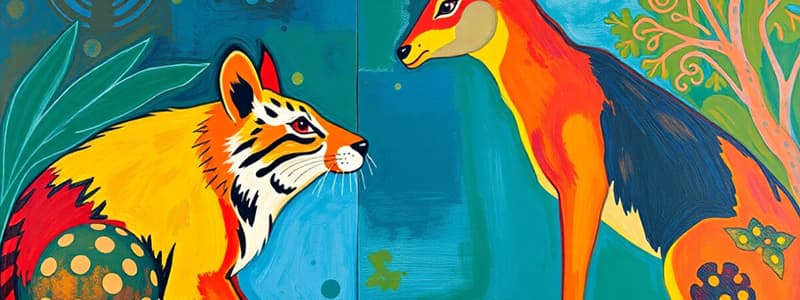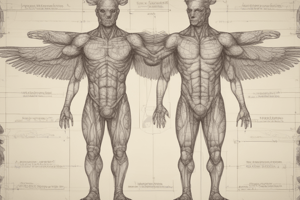Podcast
Questions and Answers
What does piloerection in animals primarily indicate?
What does piloerection in animals primarily indicate?
- An indication of dominance over others
- A behavior related to fatigue
- A signal of anxiety or excitement (correct)
- A sign of nutritional deficiency
Which body language behavior signifies that an animal is requesting more space?
Which body language behavior signifies that an animal is requesting more space?
- Stepping back (correct)
- Play bow
- Lifting one front paw
- Mounting
What behavioral signal is characterized by the animal lifting one front paw?
What behavioral signal is characterized by the animal lifting one front paw?
- Expression of aggression
- Indication of anticipation (correct)
- A sign of submission
- A playful behavior
What does a whole body shake usually signify in animals?
What does a whole body shake usually signify in animals?
Which body language behavior can be interpreted as a sexual signal or a displacement behavior?
Which body language behavior can be interpreted as a sexual signal or a displacement behavior?
What does a cat with dilated pupils most likely indicate?
What does a cat with dilated pupils most likely indicate?
When a cat's ears are perked forward, this typically signifies what state?
When a cat's ears are perked forward, this typically signifies what state?
What body language feature indicates a cat is feeling defensive or aggressive?
What body language feature indicates a cat is feeling defensive or aggressive?
What does it mean if a cat is sitting with a tucked tail?
What does it mean if a cat is sitting with a tucked tail?
In which situation would a cat likely slow blink and look away?
In which situation would a cat likely slow blink and look away?
What does a dog with a low-held tail typically indicate?
What does a dog with a low-held tail typically indicate?
Which signal indicates a dog's wish for distance during an interaction?
Which signal indicates a dog's wish for distance during an interaction?
What does it indicate if a dog's tail is both wide wagging and moving its hindquarters?
What does it indicate if a dog's tail is both wide wagging and moving its hindquarters?
Which of the following reactions indicates stress in a dog?
Which of the following reactions indicates stress in a dog?
What does it mean when a dog has visible whites of its eyes, known as 'whale eye'?
What does it mean when a dog has visible whites of its eyes, known as 'whale eye'?
What is the primary purpose of fear in animals?
What is the primary purpose of fear in animals?
Which behavior is NOT a common reaction of animals to fear?
Which behavior is NOT a common reaction of animals to fear?
In fear-free veterinary practices, what is considered a critical sensitive period in animal development?
In fear-free veterinary practices, what is considered a critical sensitive period in animal development?
What is a behavior associated with fretting in animals?
What is a behavior associated with fretting in animals?
Which of the following is NOT a strategy used in fear-free veterinary practices?
Which of the following is NOT a strategy used in fear-free veterinary practices?
Why is knowledge of animal behavior essential for veterinary care?
Why is knowledge of animal behavior essential for veterinary care?
What is one method recommended to decrease anxiety in animals during veterinary visits?
What is one method recommended to decrease anxiety in animals during veterinary visits?
Which factor is a significant cause of lasting fear of veterinary hospitals in animals?
Which factor is a significant cause of lasting fear of veterinary hospitals in animals?
What is the critical socialization period for puppies?
What is the critical socialization period for puppies?
Which of the following is a potential risk during a puppy's first fear period?
Which of the following is a potential risk during a puppy's first fear period?
What is a direct consequence of inadequate socialization in puppies?
What is a direct consequence of inadequate socialization in puppies?
During which period can puppies first develop fear-induced aggression?
During which period can puppies first develop fear-induced aggression?
What is the main method recommended for housetraining a puppy?
What is the main method recommended for housetraining a puppy?
Which factor is least associated with the development of aggressive behavior in animals?
Which factor is least associated with the development of aggressive behavior in animals?
How can castration influence aggressive behavior in male animals?
How can castration influence aggressive behavior in male animals?
What should be avoided during the critical socialization period for puppies?
What should be avoided during the critical socialization period for puppies?
What is the primary requirement for kittens regarding litter box habits?
What is the primary requirement for kittens regarding litter box habits?
What common mistake can lead to inappropriate elimination habits in dogs?
What common mistake can lead to inappropriate elimination habits in dogs?
Flashcards
Body Language in Animals
Body Language in Animals
A discipline that studies how animals use postures, gestures, and expressions to communicate.
Piloerection
Piloerection
The raising of animal body hairs, often a sign of fear, anxiety, excitement, or conflict.
Mounting Behavior
Mounting Behavior
An animal raising itself over another, possibly a sexual or displacement activity.
Play Bow
Play Bow
Signup and view all the flashcards
Stepping Back
Stepping Back
Signup and view all the flashcards
Dog Tail Wagging
Dog Tail Wagging
Signup and view all the flashcards
Dog Eye Contact
Dog Eye Contact
Signup and view all the flashcards
Dog Ears Down
Dog Ears Down
Signup and view all the flashcards
Dog Lip Curls
Dog Lip Curls
Signup and view all the flashcards
Dog's Tail Position
Dog's Tail Position
Signup and view all the flashcards
Relaxed cat eyes
Relaxed cat eyes
Signup and view all the flashcards
Fearful cat ears
Fearful cat ears
Signup and view all the flashcards
Aggressive cat tail
Aggressive cat tail
Signup and view all the flashcards
Threatening cat posture
Threatening cat posture
Signup and view all the flashcards
Cat's relaxed mouth
Cat's relaxed mouth
Signup and view all the flashcards
Socialization Period
Socialization Period
Signup and view all the flashcards
Critical Socialization
Critical Socialization
Signup and view all the flashcards
First Fear Period
First Fear Period
Signup and view all the flashcards
Second Fear Period
Second Fear Period
Signup and view all the flashcards
Fear-Induced Aggression
Fear-Induced Aggression
Signup and view all the flashcards
Positive Reinforcement in Housetraining
Positive Reinforcement in Housetraining
Signup and view all the flashcards
Elimination Area
Elimination Area
Signup and view all the flashcards
Litter Box Management
Litter Box Management
Signup and view all the flashcards
Castration in Pet Aggression
Castration in Pet Aggression
Signup and view all the flashcards
Preventing Aggression
Preventing Aggression
Signup and view all the flashcards
Fight-or-flight Response
Fight-or-flight Response
Signup and view all the flashcards
Fearful Animal Reactions
Fearful Animal Reactions
Signup and view all the flashcards
Freezing as a Survival Technique
Freezing as a Survival Technique
Signup and view all the flashcards
Sensitive Periods in Animal Development
Sensitive Periods in Animal Development
Signup and view all the flashcards
Fear-Free Veterinary Practices
Fear-Free Veterinary Practices
Signup and view all the flashcards
Gentle Control vs Restraint
Gentle Control vs Restraint
Signup and view all the flashcards
Understanding Animal Behavior
Understanding Animal Behavior
Signup and view all the flashcards
Pharmaceutical Intervention
Pharmaceutical Intervention
Signup and view all the flashcards
Study Notes
Body Language
- Body language in animals is studied by ethologists.
- Ethologists categorize body language as defensive or offensive.
- In veterinary medicine, body posture is the easiest part of body language to assess.
- Stiff, tense body posture indicates arousal of the fight or flight system.
- Arousal can also be caused by excitement.
Specific Behaviors
- Piloerection is when the hair stands up and can indicate anxiety, fear, arousal, or conflict.
- Mounting can be a sexual or displacement behavior.
- Lifting a front paw indicates the animal anticipates something.
- A play bow is an invitation to play.
- Stepping back can be a request for more space.
- A whole body shake indicates the last event was exciting or stressful.
Studying That Suits You
Use AI to generate personalized quizzes and flashcards to suit your learning preferences.




